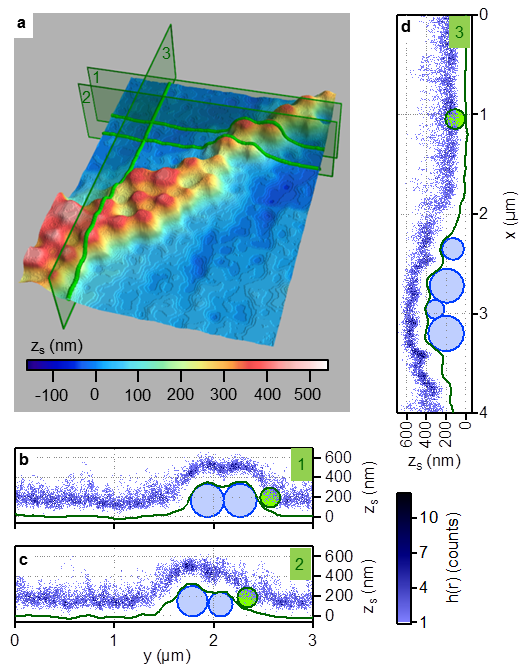Surface Imaging with optically trapped probes
| Background: Photonic Force Microscopy (PFM) is a competing technique to Atomic Force Microscopy (AFM), where the thin tip of a mechanical cantilever is scanned across the surface to obtain a high-resolution height profile. With a much higher sensitivity and an easily adjustable trapping stiffness, the PFM can generate surface height profiles using an optically trapped probe. Problem:The interferometric tracking signals of the probe's axial displacements are massively distorted by phase disturbances of the surface structure. Approach: We use two optical laser foci that scan side by side across the structured surface: one with a 190nm small optically trapped probe and the other focus without a particle. By subtracting both interferometric signals Sz from each other and extracting the high energy fluctuations, we can recover the surface height profile with a resolution beyond the optical diffraction limit. Scanning results. A polystyrene probe with 190 nm diameter is scanned across fixed silica beads with diameters of 280 to 500 nm. Top row: Sketches of a, bright field imaging (BF), b, empty scan (ES), and c, probe scan (PS). Middle row: d, BF image of the scanned region; e, axial signal Sz recorded during ES; f, axial signal Sz recorded during PS. Bottom row: g, scanning electron microscope image (SEM) of the scanned region; h, mean axial displacements (x,y) and i, reconstructed height profile h(x,y). Scalebars 1 µm. |
Figures
100.000 probe positions per second (blue dots) are tracked in 3D at a 40nm raster with a trap scan speed of 4µm/s. An area of 1µm x 1µm (625 pixel) is scanned within 10s.
| The resulting position histograms histograms are recorded convolved with the probe's shape function (sphere with D = 190nm) to obtain the lower contact surface shown in green.
Reconstructed height profile in red overlaid with sphere sizes obtained from electron microscopy
|
Publications
- L. Friedrich, A. Rohrbach
Surface imaging beyond the diffraction limit with optically trapped spheres
Nature Nanotechnology 2015, issue 10, pages 1064–1069 - Friedrich L, Rohrbach A
Tuning the detection sensitivity: a model for axial backfocal plane interferometric tracking
2012 Opt Lett, Band: 37, Nummer: 11, Seiten: 2109 - 2111 - L. Friedrich, A. Rohrbach
Improved interferometric tracking of trapped particles using two frequency detuned beams
2010 Optics Letters, Band: 35, Nummer: 11, Seiten: 1920 - 1922 - P. C. Seitz, E. H. K. Stelzer, A. Rohrbach
Interferometric tracking of optically trapped probes behind structured surfaces: a phase correction method
2006 Appl. Opt., Band: 45, Nummer: 28, Seiten: 7309 - 7315




